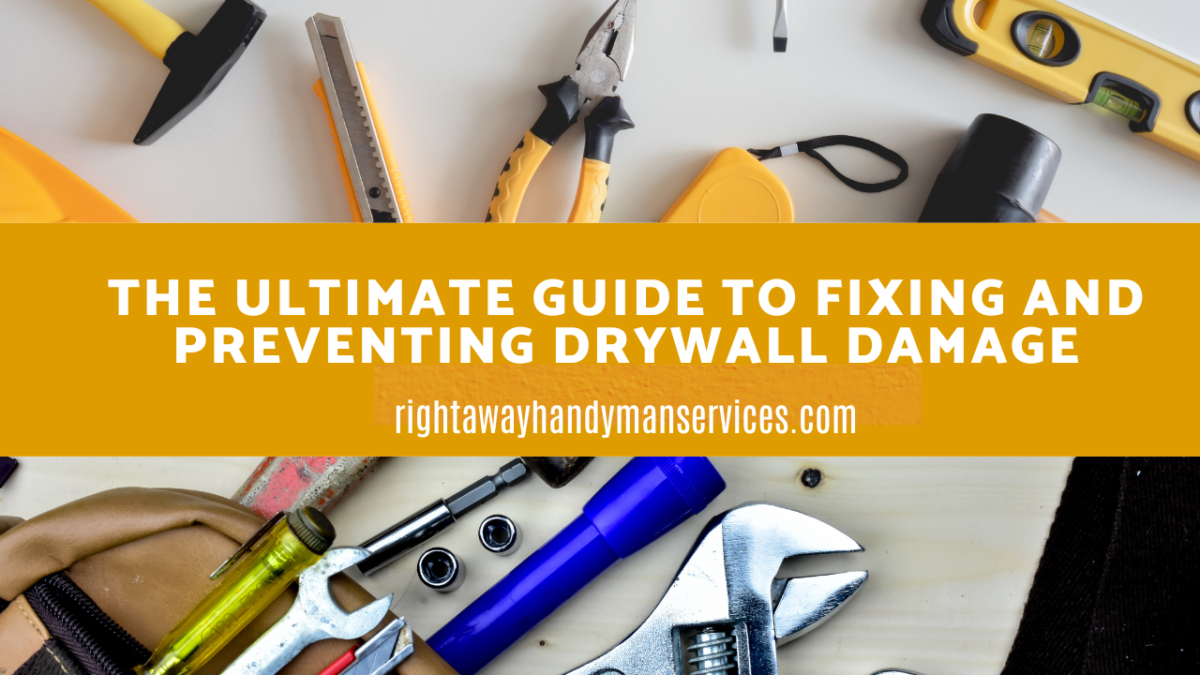The Ultimate Guide to Fixing and Preventing Drywall Damage

Your Guide to Winter Home Maintenance in NJ with Handyman Experts
November 28, 2024
What Are the Benefits of Regular Appliance Maintenance in Toms River?
January 25, 2025Key Takeaways
- Understand common types of drywall damage and their causes.
- Find out what tools and materials you need for repairs.
- Get tips for fixing both small and large drywall issues.
- Learn professional methods for a smooth finish.
- Discover ways to prevent future damage.
- Decide if you should fix it yourself or hire a professional.
Understanding Drywall Damage Basics
Drywall is a popular material used in homes. It gives us smooth walls and ceilings. However, it can get damaged over time. Knowing how to spot and fix drywall damage is important for keeping your home in Toms River, NJ looking good and safe.
Common Types of Drywall Damage
Drywall can be damaged in several ways. Each type needs a different repair method:
- Small holes and dents: These often come from doorknobs, bumped furniture, or removing nails.
- Water damage: This happens from leaks, flooding, or high humidity.
- Structural cracks: These can occur due to settling, temperature changes, or poor installation.
Recognizing these types of damage helps you understand how to fix the problem and prevent it from happening again.
Assessing Damage Severity
Before you start repairing, check how serious the damage is:
- Structural vs. cosmetic damage: Structural damage affects the wall’s strength and may need a professional. Cosmetic damage is mostly surface-level and can often be fixed yourself.
- Moisture testing: Use a moisture meter to look for hidden water damage.
- When to call a pro: Large cracks, sagging ceilings, or mold mean you should get an expert.
| Damage Type | DIY Repair | Professional Help |
| Small holes | ✓ | |
| Hairline cracks | ✓ | |
| Water damage | ✓ | |
| Large holes | ✓ | |
| Structural cracks | ✓ |
Essential Tools and Materials
Having the right tools and materials makes drywall repair easier and more effective.
Basic Repair Tools
- Putty knife: A flexible 6-inch knife works best for most repairs.
- Sanding tools: Use sandpaper or sanding sponges with different grits.
- Measuring tools: Have a tape measure, pencil, and straightedge ready.
- Safety gear: Wear a dust mask, safety glasses, and work gloves.
Materials Selection Guide
- Joint compound: Use all-purpose for most repairs and lightweight for finishing touches.
- Drywall tape: Choose paper tape for flat joints and mesh tape for corners and cracks.
- Patch kits: Handy for small to medium holes.
Pro tip: Invest in good quality tools and materials. They make repairs easier and last longer.
Small Repair Techniques
Many drywall problems can be easily fixed with simple DIY methods.
Patching Minor Holes
For small holes like those from nails:
- Clean the area around the hole.
- Use a putty knife to apply spackling paste.
- Smooth it out and let it dry.
- Lightly sand and paint to match the wall.
Crack Repair Methods
- For hairline cracks: Use a putty knife to apply joint compound, smooth it, let it dry, and sand it.
- For corner bead damage: Cut away loose material, apply mesh tape, cover with joint compound, and sand when dry.
- For larger cracks: Put mesh tape over the crack, cover with joint compound, and feather out the edges for a smooth finish.
Major Repair Procedures
Bigger drywall issues need more detailed repair methods.
Large Hole Repairs
- Cut a rectangular area around the damaged spot.
- Put wooden support behind the hole.
- Cut a patch to fit and attach it to the support.
- Apply joint tape and compound, feathering the edges.
- Sand and paint to match the rest of the wall.
Water Damage Restoration
- Remove all wet drywall, going at least 12 inches beyond what you can see.
- Use fans and dehumidifiers to dry the area completely.
- Apply an antimicrobial treatment to stop mold from growing.
- Install new drywall, tape, and finish as needed.
Caution: Always fix the source of water damage before repairing the drywall to avoid future problems.
Professional Finishing Techniques
To achieve a seamless repair, focus on details and professional methods.
Texture Matching
- Common texture patterns: These include knockdown, orange peel, and popcorn.
- Application methods: Use spray, roller, or hand-apply depending on the texture you want.
- Blending techniques: Feather the edges of the repaired area into the existing texture for a smooth look.
Paint and Final Touches
- Color matching: Use a paint chip or digital color matcher for accuracy.
- Primer application: Always prime repaired areas before painting.
- Seamless blending: Use a feathering technique when painting to blend the edges of the repair.
Prevention and Maintenance
Stopping drywall damage is easier and cheaper than fixing it later.
Moisture Control
- Improve ventilation in bathrooms and kitchens.
- Use waterproofing treatments in areas prone to moisture.
- Use dehumidifiers in basements and other damp areas.
Impact Prevention
- Install door stops to avoid damage from doorknobs.
- Use wall anchors for heavy items.
- Consider corner guards in busy areas to protect the walls.
Cost Considerations and Professional Services
Deciding whether to fix it yourself or hire a pro depends on several factors.
DIY vs Professional Repair
- Cost comparison: DIY is often cheaper for small repairs, but pros might save you money on larger jobs.
- Time investment: Think about your time value when deciding to DIY.
- Skill requirements: Be honest about your skills to avoid making mistakes that could cost more later.
Hiring Professional Services
When choosing a drywall repair service in Toms River, NJ:
- Check reviews and ask for references.
- Get multiple quotes for comparison.
- Make sure they are licensed and insured.
- Discuss the timeline and cleanup process.
For expert drywall repair services in Toms River, NJ, consider contacting Right Away Handyman Service. They provide reliable solutions for all your drywall needs.
Conclusion
Learning to repair and prevent drywall damage is a valuable skill for homeowners. From small patches to big fixes, using the right techniques and tools can help keep your walls looking great. Always assess the situation carefully, choose the right method, and don’t hesitate to call at right away handyman services NJ professionals for tougher issues. With this guide, you’re ready to handle drywall challenges and keep your home in top shape.
FAQs
- How much does professional drywall repair typically cost in Toms River, NJ?
Professional drywall repair in Toms River can range from 150 to 800 depending on the extent of the damage. Larger structural repairs or water-damaged areas may cost more. - Can I fix drywall water damage myself, considering Toms River’s coastal humidity?
Yes, small-scale water damage can be repaired with proper drying techniques and materials. However, due to high humidity near the coast, it’s crucial to address moisture sources first to prevent mold growth. - Which local hardware stores in Toms River carry the best drywall repair supplies?
Popular options include Home Depot on Hooper Ave and Lowe’s in nearby Brick Township. Both offer quality patch kits, joint compounds, and tools. - How long should I wait before painting repaired drywall in New Jersey’s climate? Allow at least 24 hours for joint compound to dry completely before sanding or painting. Humid conditions may require additional drying time.
- Do I need permits in Toms River for major drywall replacements?
For minor repairs or replacements within your home’s interior walls, permits are generally not required. However, consult the local building department if structural changes are involved.





